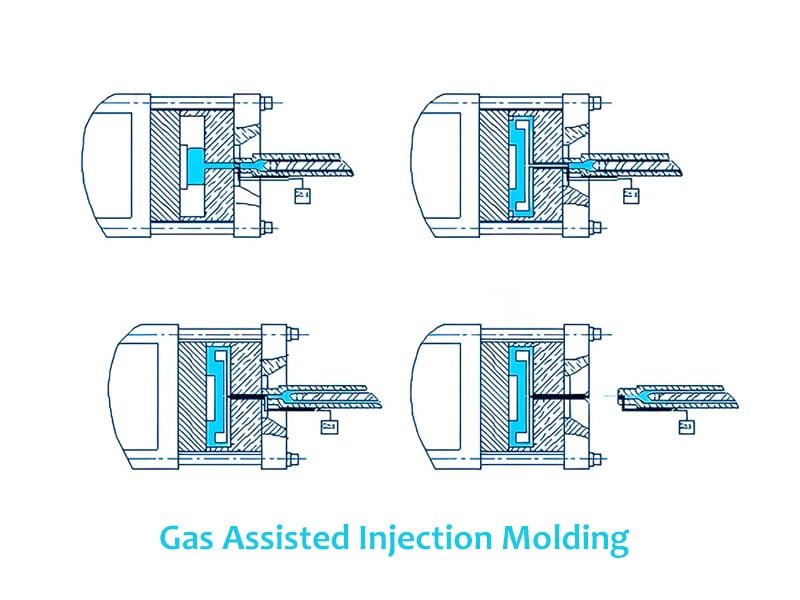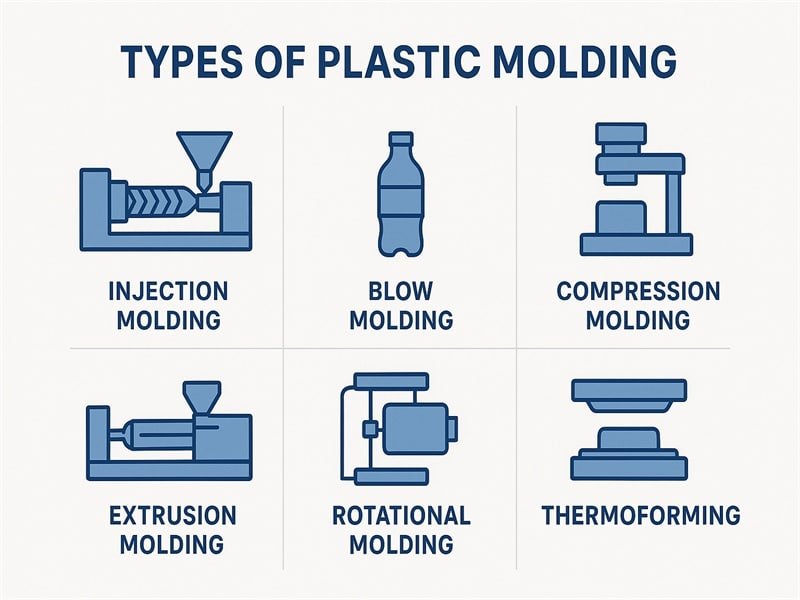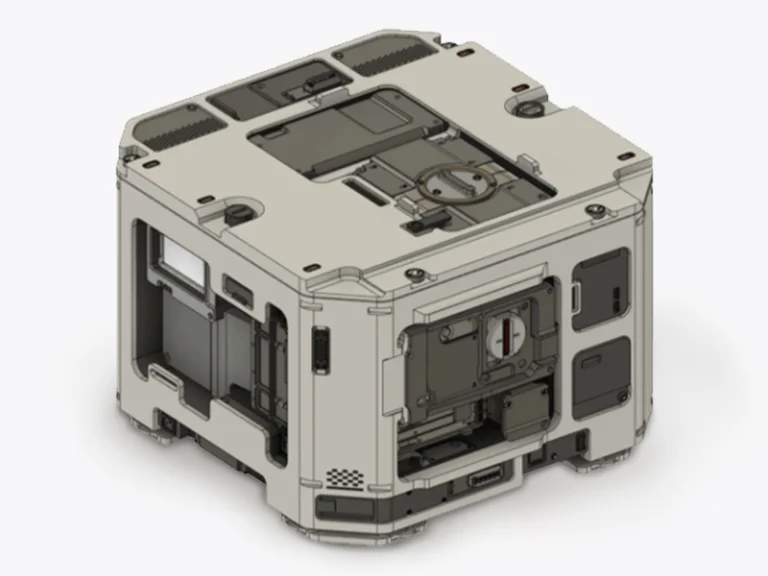Venting in injection molding is an important aspect of the injection molding process that ensures high-quality plastic parts and protects the mold. Without proper venting, this trapped air can cause various defects in the final product. The design of the venting system is critical and should be considered during the mold design phase. Factors such as vent placement, dimensions, and the number of vents all play a role in effective venting. In this post, we will explore the injection molding venting types and design considerations in injection molding.

What is the Purpose of Venting in Injection Molding?
The venting in injection molding is channels or vent holes. The purpose of the injection molding venting system is to remove air and gases from the mold cavity during the injection process. These vents are essential for preventing the accumulation of air and gases, which can cause various molding defects.
Expel Trapped Air: Venting allows air in the mold cavity and feeding system to escape as molten plastic is injected. This prevents air traps that can cause defects.
Release Decomposition Gases: It helps remove gases generated from the decomposition of plastic and additives at high temperatures.
Prevent Defects: Proper venting prevents various defects like burn marks, short shots, surface imperfections, and internal stresses in the molded parts.
Improve Part Quality: Effective venting minimizes surface defects like flow lines and weld lines, enhancing the overall quality of the product.
Optimize Molding Process: It reduces injection pressure, injection time, and pressure holding time, improving production efficiency and lowering energy consumption.
Protect the Mold: Venting helps prevent gas accumulation that can erode mold surfaces and parting lines.
Assist in Part Ejection: Venting allows air to enter the mold during part ejection, preventing vacuum formation between the product and cavity wall.
Types of Venting in Injection Molding Methods
Venting in injection molding methods are essential for ensuring the quality of molded parts by allowing trapped air and gases to escape the mold cavity. Here are the primary types of venting methods used in injection molding:
1. Parting Line Vents
Parting line vents are vents created at the parting line where the two halves of the injection mold meet. They are typically placed directly opposite the gate and at all runner ends to allow air to escape as plastic material flows into the mold cavity. They are simple to implement and easy to clean while the mold is still in the machine. However, they may not be sufficient for complex part geometries or deep cavities.
2. Vent Grooves
Vent grooves are shallow channels or grooves machined into the mold to allow trapped air and gases to escape from the mold cavity as molten plastic is injected. These grooves are typically located at the end of the melt flow path to ensure efficient venting without allowing the molten plastic to leak out. Vent grooves are particularly useful for molds that produce large and medium-sized plastic parts where a significant amount of gas needs to be removed.
3. Ejector Pin Vents
Ejector pin vents are grooves or channels incorporated along the length of ejector pins. These vents allow air to escape from the mold cavity during the injection of molten plastic and also during the ejection of the molded part. Ejector pin vents are particularly useful in molds with deep or intricate features where traditional venting methods may not be effective. Ejector pins serve the dual purpose of ejecting the molded part and providing venting, making them efficient in design and function. However, the presence of vent grooves along ejector pins may leave marks on the finished part.
4. Insert Piece Venting
Insert-piece venting involves the use of venting channels or grooves that are integrated into the mold inserts. These vents allow trapped air and gases to escape during the injection of molten plastic, ensuring that the mold cavity is filled completely and effectively. Insert piece venting is used in molds that feature ribs lattice structures, or multi-cavity molds. The vent placement is flexible without affecting the mold’s structural integrity. However, the mold design will be more complex.
5. Clearance Venting
Clearance venting utilizes the gaps or clearances between mold components, such as the space around ejector pins, core pins, and other moving parts, to allow air and gases to escape from the mold cavity. Clearance venting is particularly used for molds with deep cavities, complex shapes, or small precision parts. Clearance venting can be easily incorporated into the mold design. However, the venting capacity is limited.
6. Porous Inserts Venting
Porous inserts are made from breathable materials like sintered metals, typically stainless steel. They consist of fine particle spherical powdered stainless steel sintered at high temperature and evenly covered with tiny air venting holes. These inserts have a continuous fine porous structure that allows gases to escape while preventing molten plastic from leaking. Porous inserts venting are used in molds where traditional venting methods are insufficient. This venting method allows for continuous gas flow during the injection process. However, it may have lower strength compared to solid inserts.
7. Vacuum Venting Systems
Vacuum venting systems use vacuum devices to actively remove air from the mold cavity before or during injection. They typically consist of a vacuum pump connected to strategically placed vents in the mold. The vacuum venting system is effective for high-precision parts where air traps are a significant issue. This venting system provides thorough air removal but adds complexity and cost to the molding process.
8. Dynamic Gas Vents
Dynamic gas vents utilize specialized venting valves that actively manage the escape of air and gases from the mold cavity. Unlike traditional static vents, dynamic vents can open and close based on the pressure conditions within the mold, allowing for more efficient venting. These valves are typically placed inside the mold cavity and enable gases to dissipate through a venting channel, ensuring that the mold is adequately vented throughout the injection process. It enhances venting efficiency and can be tailored to specific molding conditions.
Professional Injection Molding One-Stop Service Company
How Does Air Escape an Injection Mold?
Air escapes from an injection mold through strategically designed venting features. These features allow air and trapped gases to escape during the injection molding process, preventing defects such as air pockets, burn marks, and incomplete fills. Here’s how it typically works:
1. Venting Channels
- Location: Vents are placed at the parting lines (where the two halves of the mold meet) or near areas where air might be trapped, like the farthest points from the injection gate.
- Design: Vents are very thin gaps, typically 0.0005 to 0.002 inches (0.012 to 0.05 mm) deep, to allow air to escape while preventing the molten material from leaking out.
2. Ejector Pin Clearance
- Ejector pins, which push the finished part out of the mold, are often designed with minimal clearance to act as secondary venting paths for air.
3. Porous Mold Inserts
- In some cases, molds use porous materials like sintered metal inserts. These materials allow air to pass through while blocking the molten plastic, enabling efficient venting in critical areas.
4. Vacuum Systems
- For complex parts or materials prone to trapping air, molds may use vacuum systems to actively pull air out of the cavity before or during the injection process.
5. Mold Design Considerations
- Proper mold design ensures air has a clear escape route.This involves:
- Avoiding sharp corners where air can become trapped.
- Designing flow paths that naturally push air toward vented areas.
Key Challenges and Solutions
- Insufficient Venting: If vents are too small or improperly placed, defects like burn marks can occur. Regular mold maintenance ensures vents remain clean and effective.
- Over-Venting: If vents are too large, molten material can seep through, creating flash. Precision in vent design is critical.
These features and practices ensure air escapes efficiently during the injection molding process, maintaining product quality and consistency.
Injection Molding Venting Design Guideline
In injection molding, the key to designing an effective venting system lies in balancing production efficiency with the quality of the final product. A well-designed venting system not only ensures smooth gas expulsion but also prevents defects like bubbles and burn marks, while ensuring proper mold filling and cooling. When designing the venting system, several factors need to be considered:
1. Assessing Venting Requirements
Product Complexity and Venting Design: Complex injection molded parts often require more venting holes to ensure smooth gas expulsion. For instance, deep cavities or molds with intricate geometries may experience difficulties with gas removal, leading to molding defects. For such complex molds, designers might need to add more venting holes in different areas of the mold or use micro-venting technology.
Mold Size and Venting Design: Larger molds generally require more venting holes to prevent gas build-up and ensure good part quality. In contrast, smaller molds need more precise control over venting to avoid too much airflow that could interfere with the filling process.
2. Position and Quantity of Venting Holes
Positioning of Holes: The best location for venting holes should be based on the gas expulsion path and the mold’s injection flow. Venting holes should ideally be placed away from the injection point to allow for even gas expulsion, without interfering with the molten plastic’s flow.
Hole Quantity and Distribution: The number and distribution of venting holes should be determined based on the mold’s size and shape. Generally, more venting holes should be placed along the mold’s periphery, while fewer should be located in the center to avoid disrupting the final product quality. A well-distributed array of holes helps ensure even gas expulsion, reducing the risk of bubbles and burn marks.
3. Hole Size Injection Mold Venting
Hole Diameter Design: The size of the venting holes should be selected according to the mold and material requirements. Typically, venting holes should have a diameter between 0.25 mm and 0.5 mm. injection mold vent depth Holes that are too large can disrupt the even flow of the molten plastic, affecting the final surface quality, while holes that are too small may fail to expel gas properly, leading to trapped air and defects.
Micro-Venting Technology: For parts with specific requirements, micro-venting technology may be used to increase the efficiency of the mold’s venting system. Micro-holes not only provide finer gas pathways but also help prevent gas accumulation and improve the surface quality of the final product.
4. Coordination of Mold Design and Venting System
Cooling System and Venting System Coordination: The cooling system of an injection mold should be designed in tandem with the venting system to ensure efficient cooling and proper gas expulsion. During design, care should be taken to avoid conflicts between the cooling channels and venting holes to ensure that both systems function optimally.
Material Selection for Molds: Directional venting channel materials, the thermal conductivity of the mold material, affects the venting design. Molds made of materials with high thermal conductivity may expel gas more quickly, allowing for fewer venting holes, whereas molds made of materials with lower thermal conductivity may require more venting holes to improve gas removal.
5. Balancing Venting and Quality
Avoiding Defects: Poorly designed venting systems can lead to various molding defects, such as bubbles, burn marks, or surface imperfections. During the design phase, the layout of venting holes should avoid over-complicating the mold structure or interfering with the molding process. A well-planned venting design ensures smooth mold filling and minimizes the chances of air pockets or trapped gases, ultimately improving product quality.
Improving Surface Finish: Proper venting design helps to reduce air pockets and burn marks, improving the surface finish of the molded parts. Effective gas expulsion ensures that the molten plastic flows evenly throughout the mold, which enhances surface quality and appearance.
6. Adjusting Venting Strategy
Venting Needs at Different Stages: The venting requirements change during different stages of the injection molding process. During filling, the venting holes must quickly expel air to avoid gas build-up. In the cooling phase, trapped gases may affect the uniformity of cooling, leading to molding issues. Therefore, mold venting designs should be flexible enough to meet the needs of each phase, ensuring balanced gas expulsion throughout the process.
7. Venting Design and Cost Control
Optimizing Venting Design to Reduce Costs: The design of venting holes impacts not only the quality of the molded product but also the cost of the mold. By precisely determining the locations, sizes, and quantities of venting holes, it is possible to reduce the complexity of mold processing, lowering manufacturing costs. Through careful design and optimization, venting systems can enhance injection molding efficiency while minimizing unnecessary expenditures.

Additional Considerations
Design vents on the cavity side of the parting surface for easier manufacturing and cleaning. Vent direction should not face the operator; use curves or bends to prevent operator burns. For thermosetting plastics, vent all shunts in front of the gate.
Consider using ejector pin vents when necessary. Ensure vents are always routed to the atmosphere.
Common Injection Mold Venting System Issues and Solutions
Here are some common injection molding defects caused by improper venting issues and their solutions:
Burn Marks Injection Molding Venting
The inadequate venting will result in the trapped air in the mold cavity being compressed and heated rapidly, and the molded part will have burn marks or discoloration on the surface.
Solutions: Improve venting at the burn mark locations. Add or enlarge existing vents, especially at the end of flow paths. Consider using vented ejector pins or porous inserts in problem areas and adjust processing conditions (e.g., lower injection speed) to allow more time for air to escape.
Short Shots Injection Mold Venting
Short shots are caused by inadequate venting, the trapped air preventing the complete filling of the mold.
Solutions: Add vent grooves or vent holes at short-shot locations. On the parting surface, create vent slots with a depth of 0.020-0.04 mm and a width of 5-10 mm. Position vent holes at the last filling point of the cavity. Use vented ejector pins in areas below the parting line. Consider vacuum venting systems for complex parts or large moldings. Increase mold temperature to improve material flow and allow more time for air escape.
Conclusion Injection Molding Venting
Proper venting in injection molding is not just a technical requirement but a critical factor in achieving high-quality injection molded parts and maintaining efficient, cost-effective production processes. By understanding and implementing effective venting strategies, manufacturers can significantly enhance their injection molding operations, leading to improved product quality, customer satisfaction, and overall competitiveness in the market.




